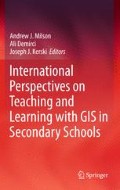Abstract
In this chapter, we discuss some of the implications of the 2006 revision of the Norwegian national curriculum. The reforms made Norway a pioneer in establishing Geographical Information Systems (GIS) in lower education since it made GIS a compulsory part of geography and geoscience. We describe the status of GIS in upper secondary school teaching by presenting prosperous case examples, a beta version of a new Web atlas for Norway, as well as the more established Google Earth. Thanks to such free Web-based applications, the chapter concludes, Norwegian school teachers do not need to change existing teaching practice significantly.
Access this chapter
Tax calculation will be finalised at checkout
Purchases are for personal use only
References
Andersland, S. (2005). GIS i geografiundervisning. In R. Mikkelsen, & P. J. Sætre (Eds). Geografididaktikk for Klasserommet. En Innføringsbok i Geografiundervisning for Studenter og Lærere (pp. 213–229). Kristiansand: Høyskolerådet.
Andersland, S. (2006). Eg syns ArcView var eit skamtøft program. Om GIS og geodata i skule og undervisning. Kart og Plan, 99(3), 195–200.
Baker, T. R. (2005). Internet-based GIS mapping in support of K-12 education. Professional Geographer, 57(1), 44–50.
Dokken, Ø., Johansen, O. I., & Øverjordet, A. H. (2004). Geografi: Landskap, ressurser, mennesker og miljø. Oslo: Cappelen.
Falch, T., Borge, L. E., Lujala, P., Nyhus, O. H., & Strøm, B. (2010). Årsaker til og konsekvenser av manglende fullføring av videregående opplæring. SØF-rapport nr. 03/10. Accessed September 10, 2010, http://www.sof.ntnu.no/SOF-R%2003_10.pdf
Fitzpatrick, C., & Maguire, D. J. (2001). GIS in schools. Infrastructure, methodology and role. In D. R. Green (Ed.), GIS: A sourcebook for schools (pp. 62–72). London: Taylor & Francis.
Goodchild, M. F. (2008). What does Google Earth mean for the social sciences? In M. Dodge, M. McDerby, & M. Turner (Eds.), Geographic visualization. Concepts, tools and applications (pp. 11–23). Chichester: Wiley.
Holt-Jensen, A. (1981). Geography: Its history and concepts: A student’s guide. London: Harper & Row.
Kerski, J. J. (2003). The implementation and effectiveness of geographic information systems technology and methods in secondary education. Journal of Geography, 102(3), 128–137.
L94. (1994). Læreplan for videregående opplæring. Geografi. Felles, allment fag i studieretning for allmenne, økonomiske og administrative fag. Oslo: Kirke, utdannings- og forskningsdepartementet.
Lisle, R. J. (2006). Google Earth: A new geological resource. Geology Today, 22(1), 29–32.
Meyer, J. W., Buttterick, J., Olkin, M., & Zack, G. (1999). GIS in the K-12 curriculum: A cautionary note. Professional Geographer, 51(4), 571–578.
Mikkelsen, R. (2009). Geografi i K06 – læreplanprosess, utfordringer og endringer. In O. Fjær & E. Eikli (Eds.), Geografi og Kunnskapsløftet. Rapport fra Norsk Geografisk Selskaps konferanse i Trondheim; Sted, levemåter og sårbarhet 27–28. mars 2008 (pp. 9–25). Acta Geographica – Trondheim. Serie B, No 16. Trondheim: Department of Geography.
Nourbakhsh, I. (2006). Mapping disaster zones. Nature, 439(16), 787–788.
Persson, A. (2007). Digital Norway. GIM international. Accessed September 14, 2010, http://www.gim-international.com/issues/articles/id816-Digital_Norway.html
Rød, J. K., Larsen, W., & Nilsen, E. (2010). Learning geography with GIS: Integrating GIS into undergraduate geography curricula. Norwegian Journal of Geography, 64(1), 21–34.
Sharpe, B., & Best, A. C. (2001). Teaching with GIS in Ontario’s secondary schools. In D. R. Green (Ed.), GIS: A sourcebook for schools (pp. 73–86). London: Taylor & Francis.
Sinton, D. S. (2009). Roles for GIS within higher education. Journal of Geography in Higher Education, 33(Supplement 1), S7–S16.
Author information
Authors and Affiliations
Corresponding author
Editor information
Editors and Affiliations
Rights and permissions
Copyright information
© 2012 Springer Science+Business Media B.V.
About this chapter
Cite this chapter
Rød, J.K., Andersland, S., Knudsen, A.F. (2012). Norway: National Curriculum Mandates and the Promise of Web-Based GIS Applications. In: Milson, A., Demirci, A., Kerski, J. (eds) International Perspectives on Teaching and Learning with GIS in Secondary Schools. Springer, Dordrecht. https://doi.org/10.1007/978-94-007-2120-3_21
Download citation
DOI: https://doi.org/10.1007/978-94-007-2120-3_21
Published:
Publisher Name: Springer, Dordrecht
Print ISBN: 978-94-007-2119-7
Online ISBN: 978-94-007-2120-3
eBook Packages: Humanities, Social Sciences and LawEducation (R0)

